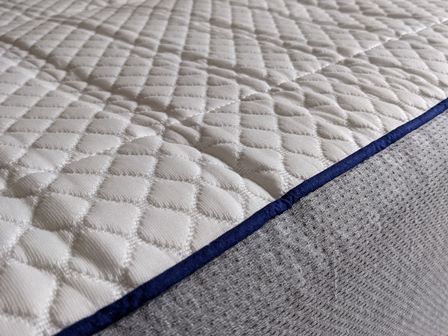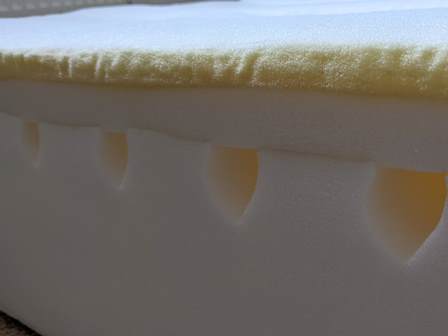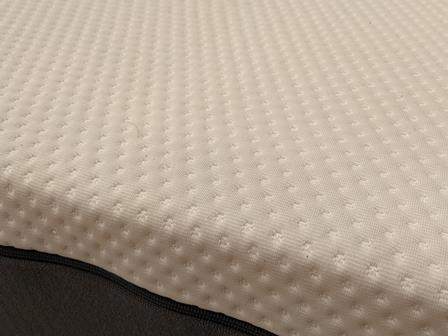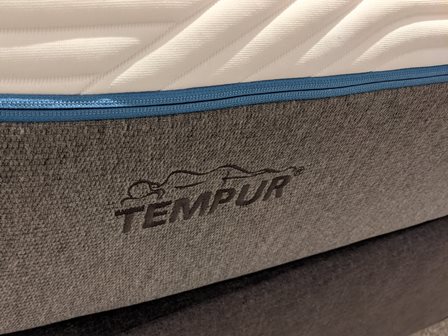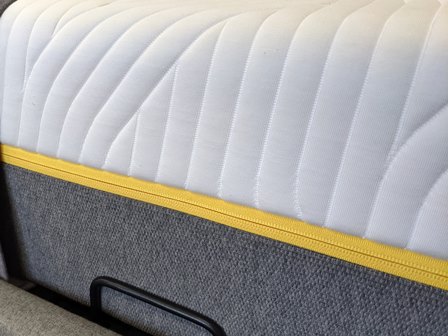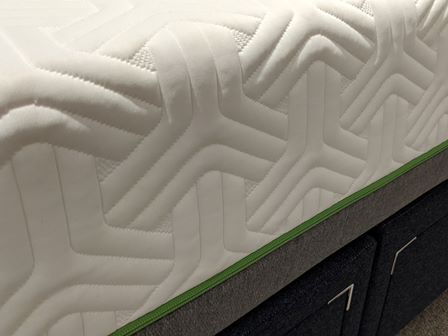The best memory foam mattress will give you consistent all-over support. But that’s not all you should look for when choosing a memory foam mattress.
Nowadays, you often get a long warranty and a risk free trial period. These guarantees and trials often surpass traditional pocket spring mattresses.
Memory foam mattresses are also good because you can use them on a divan or a bedframe/bedstead. You just need to make sure you aren’t using a flimsy old divan which can’t take the weight. If you’re using a bedframe, check it doesn’t have massive gaps between the slats.
Memory foam isn’t for everyone
On the downside, some people don’t like the odd sinking feeling of memory foam. Others find they get a bit hot on a memory foam mattress. Some companies put the memory foam as a middle layer in an attempt to improve the heat issue. A cooler material is used on top. Other companies keep the memory foam on top but use magical techniques to make it more ‘breathable’ than older memory foam.
We’ve picked out 6 of the best memory foam mattresses on the UK market in 2024. Our choices are based on customer reviews, awards and value for money. Prices are for double mattresses. Prices and review scores are correct at the time of writing.
1. Nectar Sleep Memory Foam Mattress (medium/firm – £600)
Nectar Sleep is one of the newer ‘bed in a box’ memory foam mattresses on the market. However, it offers a longer warranty and home trial than any other memory foam mattress we’ve found.
In fact, the warranty lasts ‘forever’ and you can try it out at home for a whole year. Check the FAQ for terms and conditions. Most similar mattresses offer a 10 year warranty and a 100 night trial.
Reviews average 4.3/5 on TrustPilot and it has been given a thumbs up by several expert websites, including Good Housekeeping and Ideal Homes. It cunningly puts a ‘cooling layer’ on top of the memory foam layer in an effort to stop you feeling hot.
It’s 25cm deep, which is similar to the Emma Mattress. You’ll find that cheap mattresses are thin. These don’t offer quite as much support particularly if you’re on the heavy side. The Nectar Sleep has a weight limit of 46 stone. That is much higher than most mattresses on the market in the UK.
Is this mattress good for the planet?
It’s worth considering studies into the environmental impact of memory foam mattresses. A team of researchers in Portugal found that foam mattresses have ‘a higher environmental impact’ than a pocket sprung mattress. Both types of mattress had issues but they said that the ‘manufacturing process’ is the ‘main issue’ for a foam mattress .(See Lanoë, Simões et al, 2013).
However, Nectar Sleep’s ‘mattress production is certifiably climate neutral’. The company say that they ‘calculate the carbon footprint from our manufacturing process, find strategies to reduce this, and offset the remainder’ (Nectar Sleep’s sustainability page).
Nectar will also take away your old mattress for a fee and attempt to recycle it. Lots of ‘bed in a box’ companies don’t offer this so you have to persuade the council to do it or stick it on your roof rack.
[affcoups id=”3062″]
2. Ergoflex 5G Memory Foam Mattress (medium/firm – £966)
The Ergoflex memory foam mattress is another ‘bed in a box’ which comes with a ‘risk-free’ trial period. It’s a 30-day trial rather than the 200 days you get with the Emma Mattress or the 365 days you get with Nectar Sleep.
We’ve included it because of its outstanding TrustPilot reviews which average 4.8/5. That makes it the joint highest scoring mattress brand at the time of writing. Posh latex mattress brand Dunlopillo is also up there. See the full list here.
The Ergoflex 5G has got a generous 9cm layer of memory foam on top. Some budget memory foam mattresses only have a 2cm or 3cm layer (see the Silentnight 3 Zone further down this list).
Independent experts gave it rave reviews and it comes with a 10 year guarantee. It comes in a box and then magically expands on arrival, much like most of the other memory foam mattresses on this list.
It’s 23cm deep, so slightly thinner than the Nectar Sleep. I wouldn’t say that’s a major thing.
[affcoups id=”3120″]
3. Emma Mattress (medium firmness – £299)
Customers and experts fall over themselves to say nice things about The Emma Mattress. It’s also known as the Emma Original.
As with several others on this list, you get a generous guarantee of 10 years. You also get 200 days to try it out at home before deciding if you want to keep it.
It’s been given approval by experts including Ideal Home and Good Housekeeping. Customer reviews are averaging 4.5/5 on Amazon. The brand as a whole scores 4.3/5 on TrustPilot, which is decent but not quite as high as Ergoflex (4.8/5).
It’s also worth saying that this mattress sandwiches memory foam in between two other types of foam. The top layer is a breathable foam with the odd name of Airgocell. The idea is that you won’t get as hot in bed and you don’t get as much of a sinking feeling as you usually get with a memory foam mattress.
Read our full Emma Mattress guide.
[affcoups id=”3273″]
4. Studio By Silentnight (medium – £679)
Studio by Silentnight is worth a look because it’s made by the biggest name in the UK mattress market.
It’s a medium firmness memory foam mattress which has been given a glowing report by independent expert testers. Customer reviews are 9/10 on Mattress Online.
It’s worth noting that it comes with a 60 night ‘comfort trial’ during which time you can swap it for a different firmness. Some others on this list come with a ‘risk free’ 100/200/365 night trial, so you can send it back for a refund (e.g. Emma, Nectar).
The memory foam layer is towards the middle of the mattress, which aims to stop you feeling too hot. Overheating is a common complaint about memory foam.
Most sizes arrive squashed up so they can be carried upstairs, although the larger versions come flat. It’s 26cm thick, which is a sign of good quality. Most high quality mattresses are 25cm deep or more.

[affcoups id=”3548″]
5. Silentnight 3 Zone Memory Foam Mattress (medium firmness – £202)
The Silentnight 3 Zone mattress is a decent budget memory foam mattress which gets good customer reviews on Amazon (4.2 out of 5) and on Mattress Online (4.0/5). It is made by the biggest name in the UK mattress market.
It’s a little bit thinner than the more expensive memory foam mattresses on this list at 18cm deep. However, it should do the job as long as you aren’t much heavier than average.
The top layer of memory foam is only 3cm deep, which is where the main cost cutting has been made. The ‘3 Zone’ name means that it is firmer towards the middle where your bottom rests and softer for your head and your feet. That’s a good thing, apparently.
We carried out a keyword analysis of the 8000+ Amazon reviews of the Silentnight 3 Zone. 448 customers called it ‘good value’ or said it offered ‘value for money’. However, 152 customers mentioned a ‘chemical smell’ in their reviews. This ‘off gassing’ is a common issue with foam mattresses. It is usually resolved with several hours or sometimes days airing with an open window.
There’s also a slightly more expensive 7 Zone version which is 2cm thicker for an extra £50ish. I’ve seen them both in Black Friday sales at a bargain price.
[affcoups id=”3318″]
6. Tempur Original/Cloud/Hybrid/Sensation Memory Foam Mattress (soft/medium/firm – £1749)
Tempur mattresses cost three times as much as most foam mattresses. However, they’re the original and the best according to some people.
The company took NASA technology and developed it into the first memory foam mattress. Other companies have been trying to catch up since.
Tempur sell four different mattresses which are available in different thicknesses, depending in your budget:
- Mattresses labelled Tempur ‘cloud’ are soft
- Tempur ‘original’ mattresses are medium firmness (previously called ‘Contour’)
- ‘Hybrid’ mattresses are made with a mix of foam and springs and are medium firmness.
- ‘Sensation’ mattresses are the firmest Tempur option
In each category you can pick a ‘supreme’ (cheapest) ‘elite’ (mid-priced) or ‘luxe’ (most expensive). The main difference is the thickness of the mattress. Heavier people will benefit from the thicker options.
We’ve picked this ‘elite’ 25cm deep one which gets strong customer reviews. There is also a 21cm version which is cheaper and a 30cm version which is more expensive. Tempur offer a 100 night trial, so you can send it back if you don’t think it’s worth the money (check the Ts & Cs).
Tempur are scoring 3.7/5 on TrustPilot. Tempur reviews on Dreams are mostly 4.5/5 or higher. Read our full Tempur guide.
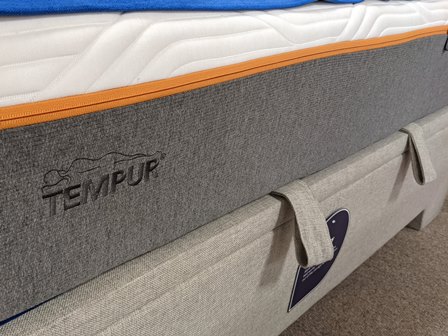
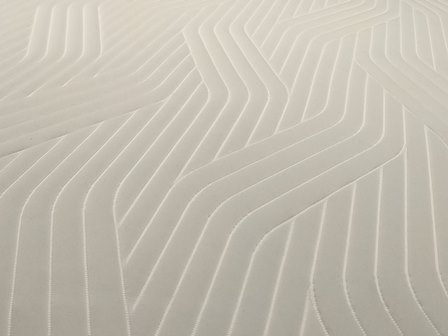
[affcoups id=”3535″]
The science of supportive sleeping
A small number of scientific studies have looked at how well people sleep on a variety of mattress types.
A study in China by Hou and Zhang in 2020 is worth a mention as they worked with back sleepers and side sleepers of different ages. The younger and middle-aged people who slept on their back and side gave a ‘high evaluation’ of memory foam and latex mattresses. (‘The young and middle-aged subjects had high evaluation on memory foam, and latex mattress in supine and lateral position’).
They also found that slightly older people had a positive response to memory foam.
The oldest participants in the trial preferred the memory foam mattress for side sleeping. However, they preferred the ‘coir and cotton’ mattress for sleeping on their back (read the summary here).
How much memory foam is in the best memory foam mattress?
A key thing to look at within the specifications of a memory foam mattress is how much is actually made from memory foam. Generally, about 2cm – 10cm of the mattress will be memory foam. Other types of foam make up the rest of the mattress.
For many years, most mattresses used memory foam as the top layer. Nowadays, several mattresses use memory foam lower down and other types of foam on top.
Our graph shows the amount of memory foam on six popular mattresses:
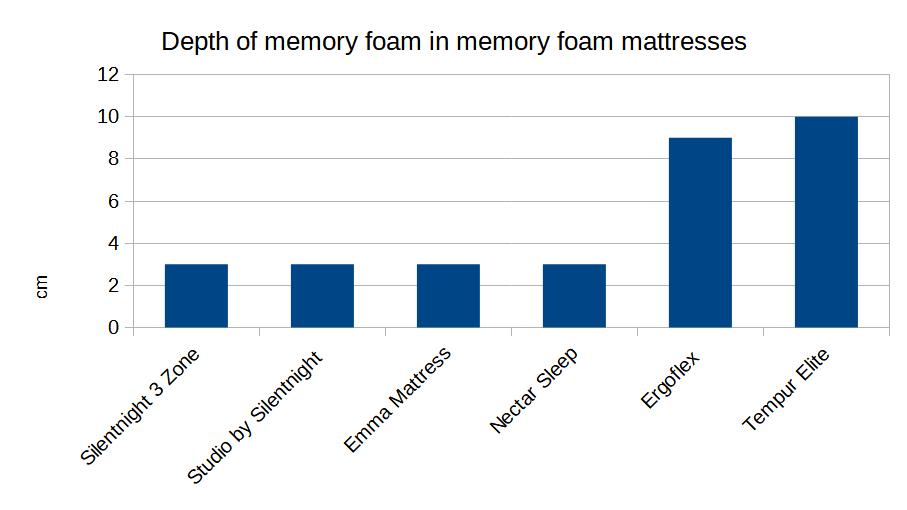
Our graph above seems to show that the Tempur ‘original’ Elite and the Ergoflex 5G have the most generous layer of memory foam.
However, it’s not quite as simple as saying that the mattress with the most memory foam is the ‘best memory foam mattress’.
For starters, The Emma Mattress and Studio by Silentnight have decided to use alternatives to memory foam on their top layer. Both use memory foam lower down in an effort to make the mattress more breathable and less warm. Secondly, the Tempur Elite has a 2cm layer of ‘Tempur Comfort’ material and 8cm of ‘Tempur Support material rather than straightforward memory foam.
The importance of not overheating in bed
Maintaining a regular temperature during the night is a key factor in determining how well we sleep. Bischof, Madsen et al studied this topic and published their findings in 1991. Their research paper was called ‘Sleep and the temperature field of the bed’. They found a ‘correlation between the quality of sleep and the variations of temperature’. They also said that ‘larger fluctuations of temperature in the bed are connected to a shorter deep-sleep time.’
Studio by Silentnight has a 4cm layer of ‘Geltex’ which aims to have ‘enhanced breathability’ and responds slightly differently. That makes a total of 7cm of memory foam and Geltex.
Meanwhile, The Emma Mattress has a layer of Airgocell which is ‘very open pored’. It has ‘an air percentage of approximately 50%’ in an effort to make a ‘comfortable sleeping climate’.
The Tempur Elite has caveats all of its own as they don’t actually make memory foam mattresses. According to Dreams ‘TEMPUR mattresses are similar to memory foam mattresses’.
The company explains that their ‘Tempur material’ is ‘not just any memory foam’. It provides some criticism of what it considers ‘standard memory foam’. For example, Tempur say that ‘It is our opinion that standard memory foam mattresses are not very effective when it comes to relieving pain and pressure’.
As mentioned earlier, the Elite model has a 2cm layer of ‘Tempur comfort material’ and then a deeper 8cm layer of ‘Tempur support material’. Our graph shows the total of the two layers and classes them as memory foam, but that is something of an oversimplification.
Are memory foam mattresses good for your health?
There’s a bit of heated debate about what happens when you sleep on a foam mattress.
This was explored in an article by WebMD called ‘Is Your Mattress Releasing Toxins While You Sleep?’. It suggests that ‘your body heat might trigger the release of potentially harmful chemicals from your mattress.’ The article refers to a piece of research which was carried out by Dubowski, Sabach et al in 2019. It was titled ‘Volatile Organic Compound Emissions from Polyurethane Mattresses under Variable Environmental Conditions’.
The issue relates to volatile organic compounds (VOCs) which you have probably seen referred to on the side of a tin of paint.
According to the article, ‘Mattresses are known to release minute amounts of (these) gaseous chemicals’. It suggests that it is ‘mainly from the polyurethane used in the mattress’. According to Wikipedia, ‘Memory foam consists mainly of polyurethane as well as additional chemicals increasing its viscosity and density.’
The WebMD article later says that ‘Mattresses containing cotton, wool and natural latex will all produce lower levels of gases’.
We’ve got a guide to ‘natural mattresses’ and other guides about wool mattresses and latex mattresses if that’s what you’re after.
However, keep reading before you leap to a conclusion. The article notes that ‘The estimated doses of most VOCs remained well below the levels that could cause health effects’
What’s the best memory foam mattress for children?
One final thing from the article worth noting is that ‘Experts are generally more concerned about children’s exposure to VOCs’. It suggest that ‘even if these chemicals don’t do immediate harm, there is concern that exposure will increase their lifelong risk of cancer’.
Of course, health is a complicated thing and a big factor is how well you sleep each night.
On that note, a study worth mentioning explored the relationship between the type of mattress you use and the quality of your sleep. It was carried out in 1997 by Scharf, Stover et al and compared two mattresses. The first was an ‘experimental foam surface’ and the second was a ‘high quality innerspring hospital mattress’. An ‘innerspring’ mattress is the name for a sprung mattress in the USA.
If had the title of ‘Comparative Effects of Sleep on a Standard Mattress to an Experimental Foam Surface on Sleep Architecture and CAP Rates’.
The CAP mentioned in the title is something called the ‘cyclic alternating pattern’. These are patterns of how we behave in our sleep. According to the study, poor quality sleep is often linked to ‘elevated CAP rates’.
In this study researchers found that ‘CAP rates were significantly reduced on the foam surface’. That seems to be a victory for foam mattresses.
However, the study also found ‘no differences in sleep stages, number of wakes, or total sleep time’ between the two mattresses.
Is a memory foam mattress the best for allergies?
You may have read that memory foam mattresses are much better for people with allergies to dust mites.
I’d say that this issue is up for debate as a Norwegian study produced contrary results (Schei, Hessen and Lund, 2002).
Instead, they suggested that ‘A simple replacement of foam mattresses with spring mattresses may reduce the exposure to house‐dust‐mite allergens.’
Do memory foam mattresses and synthetic materials make you feel warm?
A common concern or issue raised with memory foam mattresses is that they make you feel too warm.
Several foam mattress manufacturers have offered solutions to this. For example, The Emma Mattress reckons that its top layer of Airgocell is ‘very open pored’ to keep you cool. The Nectar Sleep Memory Foam Mattress offers a ‘cooling layer’.
Some academic research was carried out into this topic in Japanese in 2018 by Chiba, Yabi et al. The research compared what it called ‘high rebound mattress toppers’ with ‘low rebound mattress toppers’. To clarify, a memory foam mattress is considered ‘low rebound’ as it takes longer to return to its original shape than other materials.
A Tempur product was amongst those used in the study as an example of a low rebound product. A product which was a ‘polyethylene fiber-resin-based mattress topper’ by a company called Airweave was used as an example of a high rebound product. The toppers were put on top of standard mattresses and volunteers had their body temperatures checked throughout the night. I won’t go into the details of how they checked, but it doesn’t sound very comfortable.
The study found that amongst ‘young adult males’ body temperature was consistently lower with the ‘high rebound’ topper compared to the memory foam-type topper. At certain times of night, the difference between the two was less than 0.1°C. However, at around 2am, the difference peaked at about 0.3°C.
A similar study was carried out with older sleepers. It found less of a difference but that the ‘high rebound’ product was still slightly cooler.
Are natural materials better at keeping you cool in bed than the best memory foam mattress?
Meanwhile, another study was carried out in 2016 by Shin, Halaki et al called ‘The effects of fabric for sleepwear and bedding on sleep at ambient temperatures of 17°C and 22°C’. As astute readers will note, this was a study more about what we wear in bed and the bedding we use rather than mattress materials. I mention it as there some general principles about wool, cotton and synthetic materials which are worth exploring.
Their study took a group of 17 sleepers and tested how they responded to different materials whilst they slept. The sleepwear compared cotton v merino wool (both naturally breathable materials). The bedding comparison was between polyester (a synthetic material) and wool (a natural material). It focused on wool and the authors thanked the ‘Australian Wool Innovation Ltd (AWI) for financial support’ in carrying out the study.
A key result was that ‘Sleeping in wool sleepwear produced a significantly shorter Sleep Onset Latency than cotton’. In simpler terms, people wearing wool fell asleep quicker.
There were also ‘Marginally significant results…observed for an increased Total Sleep Time and Sleep Efficiency when sleeping in wool compared to cotton sleepwear’. So, people wearing wool slept for a bit longer and better. However, it wasn’t as noticeable a difference as the time it took to get to sleep.
The results when they compared polyester and synthetic bedding were quite different. They referenced a study by Ha, Tokura et al. It noted that ‘when comparing cotton to polyester fabric at a body temperature of 37°C and 60% relative humidity, a higher sweating rate was observed with polyester, since polyester is less hygroscopic than cotton.’
However, in their own study they noted ‘there was no bedding effect on sleep’ and that ‘no main effects were observed for bedding types’.
How popular are memory foam mattresses?
The National Bed Federation provides some reliable data on mattress sales in the UK. The NBF is a trade body of mattress manufacturers. The figures are a little out of date, but I reckon they are still useful.
In their Mattress End of Life Report in 2019, the NBF quotes ‘official government figures‘ that 30% of mattresses sold in the UK are polyurethane foam mattresses (which includes memory foam). 1% are latex, 47% are sprung mattresses and 22% are ‘other’.
Meanwhile a survey of members of the National Bed Federation’s members records that 82% of mattresses sold in the UK are sprung mattresses. Half of those were pocket sprung and half of them were open coil.
They said that 17% are either latex foam or polyurethane, which includes memory foam. They suggest that the big difference between those two figures may be ‘due to mattresses being miscategorised, i.e. classified by their comfort layer as opposed to their core’.
There is also evidence that memory foam mattresses have risen in popularity over the last few years.
The graph below shows how many people searched for the term ‘memory foam mattress’ on Google in the UK from 2004 to today. The data is relative to the number of people using Google. It isn’t just the case that more people are connected to the internet than there were in 2004.
Interest in the term ‘memory foam mattress’ saw a steady increase for several years from a very low level in 2004 up until about 2012. Since then, the figures have stayed around the same, albeit with fluctuations throughout the year.

